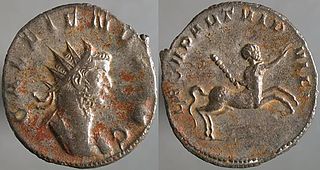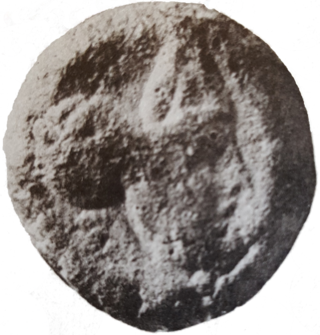
Publius Licinius Egnatius Gallienus was Roman emperor with his father Valerian from 253 to 260 and alone from 260 to 268. He ruled during the Crisis of the Third Century that nearly caused the collapse of the empire. He won numerous military victories against usurpers and Germanic tribes, but was unable to prevent the secession of important provinces. His 15-year reign was the longest in half a century.
The 260s decade ran from January 1, 260, to December 31, 269.

Year 260 (CCLX) was a leap year starting on Sunday of the Julian calendar. At the time, it was known as the Year of the Consulship of Saecularis and Donatus. The denomination 260 for this year has been used since the early medieval period, when the Anno Domini calendar era became the prevalent method in Europe for naming years.

Valerian was Roman emperor from 253 to spring 260 AD. Valerian is known as the first Roman emperor to have been taken captive in battle, captured by the Persian emperor Shapur I after the Battle of Edessa, causing shock and instability throughout the Roman Empire. The unprecedented event and the unknown fate of the captured emperor generated a variety of different reactions and "new narratives about the Roman Empire in diverse contexts".

Shapur I was the second Sasanian King of Kings of Iran. The precise dating of his reign is disputed, but it is generally agreed that he ruled from 240 to 270, with his father Ardashir I as co-regent until the death of the latter in 242. During his co-regency, he helped his father with the conquest and destruction of the Arab city of Hatra, whose fall was facilitated, according to Islamic tradition, by the actions of his future wife al-Nadirah. Shapur also consolidated and expanded the empire of Ardashir I, waged war against the Roman Empire, and seized its cities of Nisibis and Carrhae while he was advancing as far as Roman Syria. Although he was defeated at the Battle of Resaena in 243 by Roman emperor Gordian III, he was the following year able to win the Battle of Misiche and force the new Roman emperor Philip the Arab to sign a favorable peace treaty that was regarded by the Romans as "a most shameful treaty".

Gordian III was Roman emperor from 238 to 244. At the age of 13, he became the youngest sole emperor of the united Roman Empire. Gordian was the son of Antonia Gordiana and Junius Balbus, who died before 238. Antonia Gordiana was the daughter of Emperor Gordian I and younger sister of Emperor Gordian II. Very little is known of his early life before his acclamation. Gordian had assumed the name of his maternal grandfather in 238.

Philip I, commonly known as Philip the Arab was Roman emperor from 244 to 249. He was born in Aurantis, Arabia, in a city situated in modern-day Syria. After the death of Gordian III in February 244, Philip, who had been Praetorian prefect, achieved power. He quickly negotiated peace with the Persian Sassanid Empire and returned to Rome to be confirmed by the Senate. During his reign, the city of Rome celebrated its millennium.

Legio II Parthica was a legion of the Imperial Roman army founded in AD 197 by the emperor Septimius Severus, for his campaign against the Parthian Empire, hence the cognomenParthica. The legion was still active in the beginning of the 5th century. The legion's symbol was a centaur.

Septimius Odaenathus was the founder king (Mlk) of the Palmyrene Kingdom who ruled from Palmyra, Syria. He elevated the status of his kingdom from a regional center subordinate to Rome into a formidable state in the Near East. Odaenathus was born into an aristocratic Palmyrene family that had received Roman citizenship in the 190s under the Severan dynasty. He was the son of Hairan, the descendant of Nasor. The circumstances surrounding his rise are ambiguous; he became the lord (ras) of the city, a position created for him, as early as the 240s and by 258, he was styled a consularis, indicating a high status in the Roman Empire.

Roman Syria was an early Roman province annexed to the Roman Republic in 64 BC by Pompey in the Third Mithridatic War following the defeat of King of Armenia Tigranes the Great, who had become the protector of the Hellenistic kingdom of Syria.

Pitsunda or Bichvinta is a resort town in the Gagra District of Abkhazia/Georgia. Founded by Greek colonists in the 5th century BC, Pitsunda became an important political and religious centre of the region in the antiquity and the Middle Ages. Since Soviet times it has been one of the main resorts of Abkhazia.

The Battle of Edessa took place between the armies of the Roman Empire under the command of Emperor Valerian and the Sasanian Empire under Shahanshah Shapur I, in Edessa in 260. The Roman army was defeated and captured in its entirety by the Iranian forces; for the first time, a Roman emperor was taken prisoner.

Mesopotamia was the name of a Roman province, initially a short-lived creation of the Roman emperor Trajan in 116–117 and then re-established by Emperor Septimius Severus in c. 198. Control of the province was subsequently fought over between the Roman and the Sassanid empires until the Muslim conquests of the 7th century.
Gaius Furius Sabinius Aquila Timesitheus was an officer of the Roman Imperial government in the first half of the 3rd century. Most likely of Oriental-Greek origins, he was a Roman citizen, probably of equestrian rank.
Marcus(?) Aurelius Heraclianus was a Roman soldier who rose to the rank of Praetorian Prefect in the latter part of the reign of the Emperor Gallienus. He was a member of the cabal of senior commanders of the Imperial field army that plotted and achieved the assassination of the Emperor Gallienus. His subsequent fate is uncertain. The only ancient reference has him committing suicide, but the circumstances are unclear.
Lucius Petronius Taurus Volusianus was a Roman citizen, apparently of equestrian origins, whose career in the Imperial Service in the mid-Third Century AD carried him from a relatively modest station in life to the highest public offices and senatorial status in a very few years. He may have secured his first appointments before the Licinian Dynasty – – acceded to the Empire in 253 AD, but it was in the course of their reign that his upward progress achieved an almost unprecedented momentum and the second factor seems to have been a consequence of the first. The nature of his relationship to the Licinii is uncertain, but it seems likely that a common origin in the Etruscan region of central Italy at least predisposed Gallienus in his favour and he seems to have been that emperor's most trusted servant and adviser during the period of his sole reign - 260(?)-268 AD.
The Grivpanvar were an elite late Parthian and Sasanian division who fought as heavy cataphract cavalry. According to Roman sources, the Grivpanvar had the ability to impale two men on the long, heavy spears that they carried. Historical evidence suggests that the heavily armoured Parthian grivpanvar were at least partially influenced by the military of the Central Asian steppes, who in turn had inherited their armoured cavalry traditions from the Massagetae and the late Achaemenid Persians.
Strategius Musonianus was a Roman senator who served in various civilian offices from the reign of Constantine I through to Constantius II.

The Cameo with Valerian and Shapur I is now on display in the Cabinet des Médailles of the Bibliothèque nationale de France in Paris. It has the inventory number Camée 360. and was bought in 1893. The cameo is 6,8 cm high and 10,3 cm wide and made of sardonyx, and is thought to date to about 260 AD. For the carving, the different colored layers of the stone was used. The background is dark, the figures are white and details are again dark again as they are on the highest level.
Aphrahat, Aphraat, Aphraates or Afrates was a fourth-century Persian-born hermit who was active in Mesopotamia and Syria during the reign of Emperor Valens and perhaps Theodosius. His life is known only from the account of Theodoret, who was reportedly taken as a boy to visit the hermit in Antioch and was blessed by him.